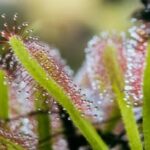As an Amazon Associate, this site earns commissions from qualifying purchases. For more details, click here.
Pitcher plants got their name because their plants look somewhat like pitchers. Naturally this brings up the question of can you, or should you, fill it with water? Plants need water obviously, so will it help to fill the pitcher with the liquid? That is the question we will answer here.
Whether you should add water to the pitcher or not depends on the species. Nepenthes pitcher plants produce liquids so it is not necessary. However sarracenia plants like S. rosea and S. purpurea will need it if their pitchers dry out. You can add water until it is 1/4 full.
When to Add Water to Pitcher Plants
You should only add water under two conditions: if the pitcher is drying out, or the plant is a sarracenia purpurea or any of its variants. Nepenthes does not need additional water. If its pitcher is dry, increase the humidity so it can produce more liquid.
Pitcher plants produce fluids to dissolve bugs and digest them. In the wild, rainwater falls into the pitcher and mixes in with the digestive liquids.
The rainwater does three things: first it drowns any insect that attempts to escape the trap. Second, liquid helps the plant -in particular S. purpurea – liquefy insect tissues, especially if its own digestive fluid is limited. Third, rainwater allows bacteria to thrive in the pitcher. These bacteria help pitcher plants break down its captured prey.
Sarracenia purpurea needs water to dissolve and digest food. Sunlight is vital for these plants, but if it gets too hot , it might dry out the pitcher.
If sarracenia pitcher plant looks dried out and its pitcher has little to no liquid, add some water. You should also move the plant under partial shade or increase its humidity.
Adding water and boosting humidity will stimulate the plant to produce its own fluids. This in turn allows bacteria to spread in the liquid. When a bug falls into the pitcher, the bacteria, water and digestive liquids will break down its tissues. Once the prey has been digested, sarracenia converts it into nitrogen and other elements to help it grow.
Should You Add Water to Nepenthes?
You can only add water to sarracenia purpurea. Do not pour water into nepenthes pitcher plants. They will not benefit from it. In fact the plant could fall over if you filled it to the brim.
If your nepenthes is too dry, it needs more humidity. You can use a Movtip Humidifier to keep the moisture and temperature constant.
Set the humidity level to 60%-80%. Keep the plant under partial cover. After a few days you will see liquid forming in the pitcher.
It is easier to control humidity if your nepenthes is indoors. Nepenthes grown in a terrarium or greenhouse have constant temperature and moisture for instance.
What Kind of Water to Add to Pitcher Plants
You can use distilled water, rainwater or reverse osmosis water on pitcher plants. Do not use tap water because it has elements that can harm plants.
Tap water has TDS (total dissolved solids), and its amount is measured in parts per million. Typical tap water in the US has 100-350 parts per million (PPM) which is mostly harmless to humans.
Pitcher plants can only handle up to 150 PPM. It is possible that your tap water has 150 PPM or less, which makes it safe for the plant. Unless you have a PPM meter it is better to be safe and use distilled, reverse osmosis or rainwater.
Rainwater is the easiest to collect if it rains frequently in your area. Get some buckets and collect the rain. Do not use transparent containers to prevent algae from spreading. Now you can add water to your sarracenia or use it to keep the soil moist.
Collecting rainwater is easy and free if it rains often. If you live in a dry region this is not practical. You must also keep an eye out for bacteria or fungi that might grow if you store the water for prolonged periods.
You can buy distilled or purified water from stores or online. If you use a lot of distilled water, it is a good idea to invest in a water distilling machine like the CO-Z 1 Gallon Water Distiller as it is cheaper in the long term. Reverse osmosis water systems are also good for pitcher plants, but they are less common.
How Much Water to Add to Pitcher Plants
Sarracenia pitcher plants benefit from water, but do not add more than 1/3 or 1/4 full. The plant may not be able to handle the weight and tip over.
Even in nature you will rarely see sarracenia pitcher plants get filled with rainwater. Their leaves deflect water off so only a small amount gets inside. S. purpurea is the exception to the rule as it allows plenty of water to get through.
Because water is so important for plants, it is tempting to fill the pitcher. This is particularly true during summer and the plant is exposed to the heat.
Before you add any, make sure that it is actually necessary. Here are the things you should look at:
- Ensure the pitcher plant is S. purpurea or one of its sub types, hybrids or variants. Other sarracenia will be fine with a bit of water too. But if you are not sure, do not add any.
- Look inside the pitcher. If there is some shallow liquid, do not add any water. The plant is fine. If the pitcher is almost or completely dry, get some water.
- Add a bit of water, up to 1/3 or 1/4 of the pitcher. Use only purified, distilled, reverse osmosis or rainwater.
- Drop a bug into the pitcher. Wait a few days and see what happens. If you only see leftover remains, the plant has recovered. it is now producing digestive enzymes.
If the insect was not eaten and there are no signs of digestive fluids, move the plant to a more shaded location. Increase the humidity and lower the temperature. This should help sarracenia purpurea recover.
Tips For Using Water on Pitcher Plants
Without water it becomes difficult for some pitcher plants to digest bugs, so make sure to keep these tips in mind.
- Know what pitcher plant you have. Only specific types of sarracenia directly benefit from adding water in their pitcher. A bit of water does not hurt nepenthes and other variants, but it is not much help.
- Use the right type of water. Distilled, reverse osmosis or rainwater. Resist the urge to use tap water.
- Add water only if needed. You have to make sure the pitcher plant is really dried out. Too much water is not good.
- Check if the plant is sick. If your sarracenia pitcher is always dry even in humid conditions, look for signs of infection or other ailments.
- Provide shade under heat. Most sarracenia can handle 90 degree temperature just fine. But if it goes above 100 and it is very arid, its fluids might dry out. A few hours of high temperature is not a problem, but if it lasts several days, it will start to affect the plant.
You can grow pitcher plants indoors or outdoors. Sarracenia requires direct sunlight so outdoors is better. In fact many growers will say that sarracenia should only be grown outdoors. But it depends on the requirements of your particular plant. Some variants like S. rosea benefit from indoor cultivation.
If you are growing sarracenia in a greenhouse, check regularly if the pitcher is drying. Since greenhouse pitcher plants are often manually fed, use that opportunity to look into the pitcher. If the setup is right, the plant should be all right.
Conclusion
In general water is good for pitcher plants regardless of the variant. Even nepenthes plants will be fine if a bit of water ends up in their traps. As long as you use purified water or rainwater, your plant will continue growing.

My fascination with carnivorous plants began many, many years ago with Venus Fly Traps. Now I am more than happy to impart what I know with other enthusiasts and those who are curious about meat eating plants.



